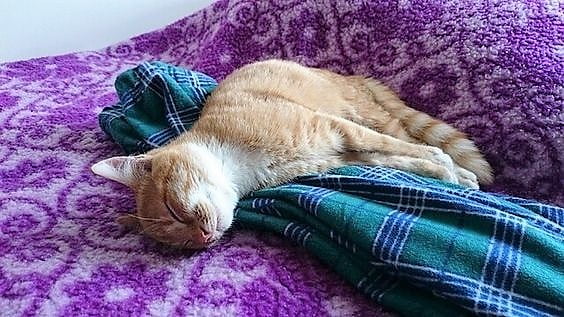
A study dated October 2021 called “The effect of owner presence and scent on stress resilience and cats” concluded that the smelly clothes of a cat’s owner do not provide comfort and reassurance to their cat during their absence. This will surprise many if not most, even all, cat owners. It goes against the grain. And I will state right away that I think this study is misguided and the outcome incorrect. I’ll explain why.
The study wanted to find out whether the unwashed clothes of cat owners help to reassure their cats when they were absent. Absence might mean during the night when the owner is asleep, when they are away from home at work or when they are on holiday and their cat is at a boarding cattery. It applies to those sorts of scenarios.
Often people leave items of unwashed clothing in cat carriers when transporting their cat and they leave items of clothing at boarding catteries to help reassure their cat during a long absence.
The study debunks the conventional wisdom that doing this reassures the cat. To stress the point: they say it doesn’t.
The three female scientists who conducted the experiment (see below) coined what appears to be a new phrase in the lexicon of cat study science namely “secure base effect” (SBE). This they say refers to a “human or non-human animal’s ability to use the presence of a bonded caretaker or other familiar stimulus as a source of comfort”. The “other stimulus” is a reference to smelly clothes. “Bonded caretaker” means owner.
They asked 42 cat owners to bring their cats and something which smelled like them i.e. unwashed clothing of some sort to an unfamiliar testing room. In other words, the cats were tested in a strange place. In essence, on my understanding of the experiment, they left the cats in this room with an item of smelly clothing to see whether the cat used the clothing to reassure themselves. By “use” I mean lay down on the clothing or sniffed it.
They concluded that when the owner was present in the room the cats, as expected, were less stressed as judged by their behaviour. However, they did not see the same lowering of stress-related behaviours when the cats were alone with the scented object (item of clothing). That’s the crux of it.
To reiterate: the “scent object” did not help to reassure the cats and make them feel less stressed in this strange place. The researchers said that their experiment provided evidence rather than anecdotal stories about how to alleviate cat anxiety.

I don’t think this study is good evidence. I’m sure cat caregivers everywhere notice that their cat snoozes on their clothes at night or sleeps on their favourite armchair when they are away from the home. Or their cat sleeps on their smelly bedclothes. Domestic cats are attracted to the body odour of their caregiver. A separation-stressed cat may defecate on their owner’s bed to merge scent as a reassurance.
When a domestic cat sleeps on a person’s lap they do so for two reasons; because it’s warm and because it smells of their human companion. It is reassuring. Scented clothing is reassuring to a domestic cat. There is no question about that. In other words, scented clothing provides a second-best SBE. But importantly, smelly clothes are not a substitute for the presence of the owner. The owner’s presence is a far stronger reassurance than their clothes and the ultimate SBE.
I think the problem with this experiment is that it was conducted in a strange place. In doing this you take the cats out of their known environment; the place that is there home, their territory, their home range. That has an all-encompassing effect on their mentality which I would argue alters natural behaviour to the point where scientist can no longer be certain of measuring natural behaviour accurately.
Placing domestic cats in an entirely strange place with strange activities masks natural behaviours until the place is no longer strange. They should have carried out the test in the homes of the cat owners and perhaps used Zoom software to watch what happened remotely.
What are your thoughts on their conclusion?
Note: The scientists are: Alexandra C.Behnkea, Kristyn R.Vital and Monique A.R.Udella who, I believe, conducted the study at Animal Health & Behavior, Distance Education, Unity College, 49 Farm View Drive, Suite 201, New Gloucester, ME 04260, USA.
SOME PAGES ON SEPARATION ANXIETY:

